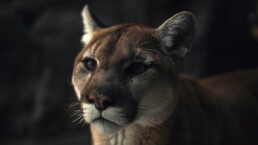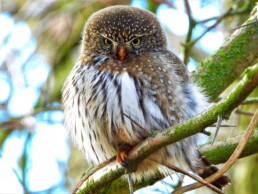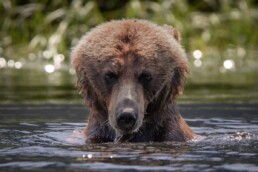Even the most dedicated anglers can’t compete with an osprey, the ultimate fishing machine that can be seen throughout the city of Castlegar, British Columbia.
Osprey are large raptors known for their impressive fishing skill. Once they arrive in the Castlegar area in April or May, they can usually be found flying above their favoured fishing grounds along the Kootenay and Columbia rivers. Watching an osprey hunt for fish is an incredible wildlife viewing experience.
Also known as:
- Pandion haliateus
- ȼ̓u- ȼ̓u (Ktunaxa)
- tsícwets’ecw (Secwepemctsin)
- c̓ix̌ʷc̓x̌ʷ (nsyilxcǝn)
- fish hawk
Description:
- A large raptor with a distinctive M-shaped flight silhouette, created by a unique kink in the wings).
- Individuals have white plumage with dark brown back, prominent dark eye streak, dark wrist patches and on females, a “necklace” of dark streaks on the breast.
- Wingspan is 147-183cm.
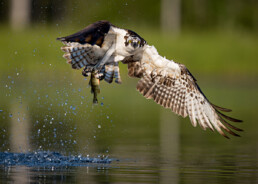
Habitat:
- Riparian areas such as shorelines or forest edges adjacent to water.
- Ospreys build large stick nests in tall trees, snags or manmade structures such as utility poles, bridge posts, pilings and nest platforms near water.
Viewing Opportunities:
- You can find osprey anywhere there is water!
- Watch for them in the skies above the Columbia River near Millennium Park, Selkirk College, Syringa Provincial Park or Waldie Island for example.
- Or look for their conspicuous big stick nests along shorelines.
- Osprey can typically be seen in Castlegar from April to October.
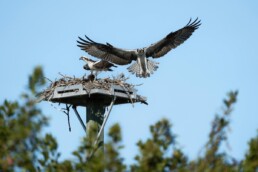
Behaviour:
- Osprey communicate with high-pitched whistling chirps. Alarm calls are a rapidly increasing set of shrill chirps.
- Osprey tend to mate for life and often return to the same nest site every year. The female lays three eggs and does all of the incubation, while the male does all of the fishing to feed the female and the young once they hatch.
- Osprey hunt by flying over shallow water, looking for fish. Once they spot a fish, they will hover briefly in the air before folding their wings and dropping into a fast dive, feet first. They splash into the water, disappearing completely, before emerging with a fish gripped in their talons.
- Ospreys mate for life but spend the winters apart. Females leave British Columbia first in the late summer, leaving males and juveniles behind. They will migrate up to a month later.
- They migrate individually and spend the winter in different wintering grounds. Amazingly, the pairs return to the nest within a week of each other in the spring. (The males arrive first.)
- Juveniles will spend 18 months in wintering grounds after their first migration before returning to BC to breed.
- Typically they live 7-10 years, but can live up to 25.
Diet:
- Ospreys are piscivores, eating almost exclusively fish.
- They may also eat the occasional rodent or bird.
Connections:
- Osprey populations were nearly wiped out by DDT use between the 1950s and 70s. The pesticide caused thinning of eggshells, which reduced reproductive success. Thankfully osprey have made a remarkable recovery.
- Osprey nest webcams are popular among many birdwatchers. FortisBC manages a webcam at a nest in the nearby city of Kelowna.
Cool Facts:
- Osprey feet are uniquely adapted to catching fish. Unlike other birds of prey that have three forward-facing toes and one hind toe, the osprey can swing its outer toe to the back to help them carry fish parallel to their bodies in flight. Sharp spicules on the bottoms of their feet also aid in gripping slippery fish.
- Osprey are the most widely distributed bird of prey and can be found on every continent except Antarctica.
- Osprey nests are huge! They typically measure about 1-1.5m across and 0.5m deep, but as they add to the structure year after year, they can reach depths of 3m.
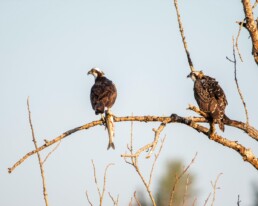
The goal of wildlife viewing is to safely appreciate the animals in their natural surroundings with minimal impact. To achieve that, here are eight tips:
- Be respectful. Getting too close or staying too long can disrupt feeding and other important behaviours and can cause stress and unpredictable behaviour.
- Give wildlife lots of space. If an animal responds to your presence (eg: looks up, watches you, moves away), you are too close.
- Viewing roadside wildlife can have negative impacts on wildlife by disrupting feeding and leading to habituation to traffic and people. If you spot wildlife while driving, pull over only if it is safe to do so and keep your stop short and sweet.
- Keep dogs on leash and under control at all times to avoid negative encounters
- Carry bear spray and know how to use it.
- Use binoculars and zoom lenses.
- Never feed wildlife.
- Leave no trace. Pack it in, pack it out.
Get To Know The Wildlife Of Castlegar
April 3, 2025
Meet Castlegar Photographer Jamie Isaacs
March 1, 2025
Meet Castlegar Photographer Josh Fogal
March 15, 2024


